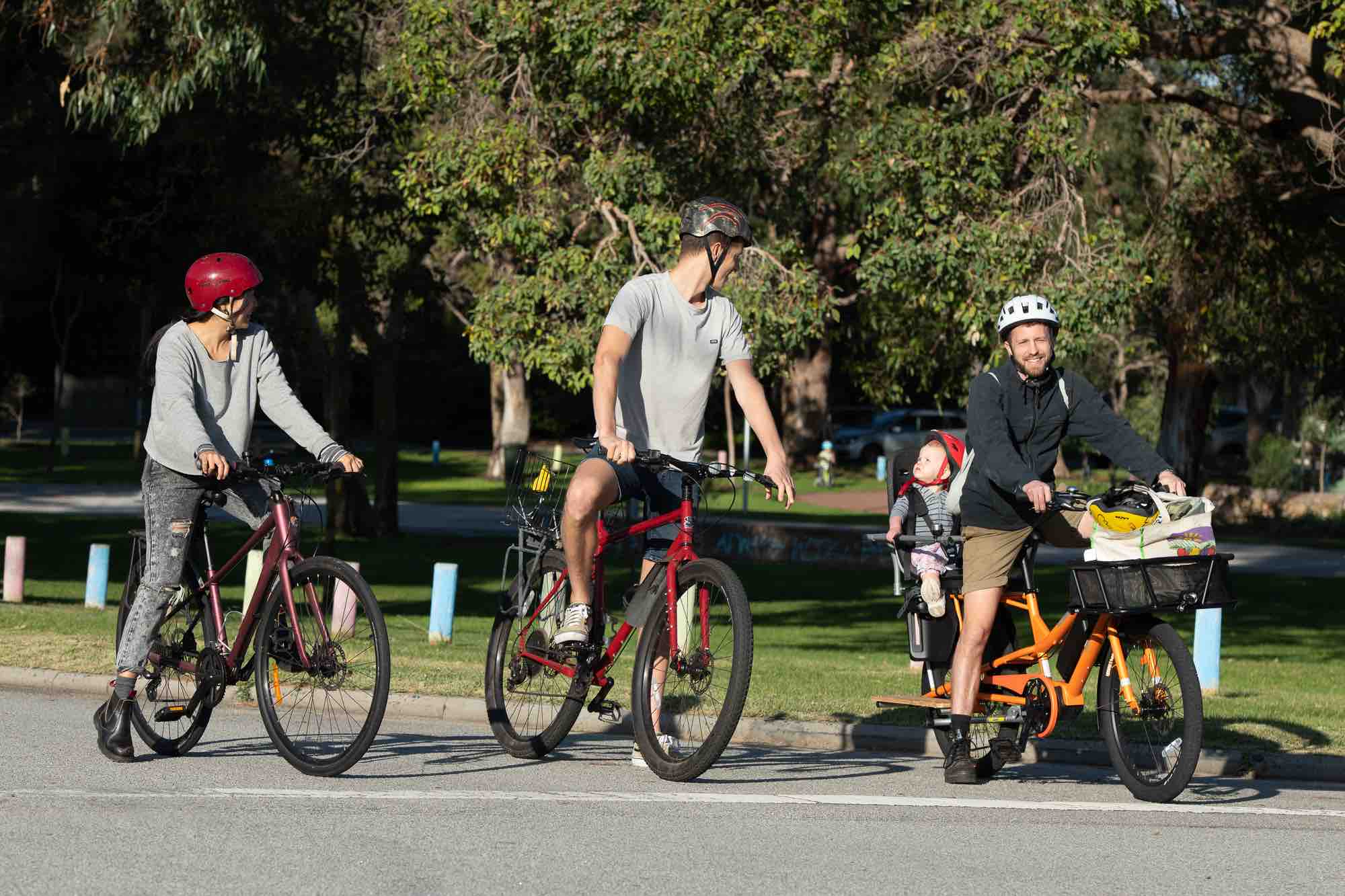OUR ACTIVE TRANSPORT VISION

OUR VISION FOR ACTIVE TRANSPORT
WestCycle’s Vision is for everyone to be able to use active transport for their daily journeys, because we know that more people walking and riding benefits the whole community.
Our Vision assumes that:
- Streets are for everyone, no matter their age, ability, gender or background.
- Cities and towns are better places for everyone when both policy and the built environment are designed to support active transport.
WHAT WOULD MAKE OUR VISION POSSIBLE?
1. GOVERNMENT POLICIES SUPPORT PEOPLE TO USE ACTIVE TRANSPORT
Our elected members, whether local, state or federal, understand that by supporting people to use active transport they can use government funds to achieve progress across a range of metrics including physical and mental health, social cohesion, education, productivity, biodiversity and climate change. They are committed to the United Nations’ recommendation that at least 20% of transport budgets be spent to support walking and cycling[1].
2. LOCAL STREETS MEET PEOPLE'S BASIC NEEDS
Local streets prioritise the basic needs of all people and in doing so make it more attractive for everyone to walk, ride and spend time on the street[2]. This means that people using the street would find:
- The air is clean
- They feel relaxed
- There are things to see and do
- They feel safe
- People choose to walk and ride
- The street isn’t too noisy
- There are places to stop and rest
- There is shade and shelter
- The street is easy to cross
- Everyone feels welcome.
When streets meet the above needs, everyone has the option of walking or riding.[3],[4],[5],[6]
3. LOCAL STREETS HAVE SLOWER SPEEDS AND LESS MOTORISED TRAFFIC
On local streets, traffic travels at low speeds and there is a low volume of motorised traffic. Local streets prioritise people using active transport.[7]
4. EVERYTHING PEOPLE NEED DAY-TO-DAY IS CLOSE BY
Homes, parks, shops, businesses, schools, health centres, day-care, and other services are all within easy active travel distance of each other. As a result, people have almost everything they need day-to-day close by.[8]
5. THERE'S SAFE SPACE FOR PEOPLE TO RIDE
A network of wide, comfortable paths allows people using active transport to give each other space while staying separate from motorised traffic. Paths are wide enough for two people to comfortably ride next to each other and have a conversation. The network of paths makes it easy to travel from home to work, recreation, school and services, whether locally or longer distance. All paths are well lit and looked after, so they are always safe and pleasant to use.[9],[10]
6. IT'S EASY TO CONNECT WITH THE TRAIN OR BUS
For longer journeys, train and bus stations are always an easy ride away. Bikes and scooters are accommodated on trains and buses, so that everyone has a range of travel options available to them for their whole journey. Train and bus stations have secure parking available where taking a bike or e-rideable on public transport is either impossible or undesirable.[11]
7. THERE ARE SAFE AND CONVENIENT PLACES TO PARK
All active transport journeys end with safe, secure parking for your bike or e-rideable, whether the journey is for shopping, out for dinner, or to work for the day. Parking is in well-lit, public locations close to major destinations, and accommodates a range of bicycles, cargo-bikes, electric bikes, tricycles and e-rideables. End-of-trip facilities are available for commuters. People living in accommodation with limited space can access publicly located bike parking that is protected from the weather in convenient, safe places. [12]
8. IT'S EASY TO CONNECT WITH NATURE ON YOUR JOURNEY
REFERENCES
[1] United Nations Environment Program (2016), Urgent investment needed in walking and cycling infrastructure to save millions of lives and combat climate change, https://www.unep.org/news-and-stories/press-release/urgent-investment-needed-walking-and-cycling-infrastructure-save
[2] Healthy Streets (2022), https://www.healthystreets.com/
[3] Arup and Sustrans (2019), Inclusive cycling in cities and towns, https://www.arup.com/perspectives/publications/promotional-materials/section/inclusive-cycling-in-cities-and-towns
[4]Lusk, A. (2019) “Bike-friendly cities should be designed for everyone, not just for wealthy white cyclists”, The Conversation
[5] Strong Towns podcast featuring an interview with Melody Hoffman, author of Bike Lanes are White Lanes: Bicycle Advocacy and Urban Planning
https://www.strongtowns.org/journal/2018/1/4/are-bike-lanes-white-lanes
[6] Doucet, B. & Mazumder, R. (2020) “COVID-19 cyclists: Expanding bike lane network can lead to more inclusive cities”, The Conversation, https://theconversation.com/covid-19-cyclists-expanding-bike-lane-network-can-lead-to-more-inclusive-cities-144343
[7] Mclaughlin, M., Beck, B., Brown, J., Sharkey, M. (2021) “Busted: 5 myths about 30km/h speed limits in Australia”, The Conversation, https://theconversation.com/busted-5-myths-about-30km-h-speed-limits-in-australia-160547
[8] Sisson, P. (2020) “What is a 15 minute city?”, City Monitor, https://citymonitor.ai/transport/pedestrians/what-is-a-15-minute-city
[9] Pucher, J., & Buehler, R. (2008). Making cycling irresistible: Lessons from the Netherlands, Denmark and Germany. Transport Reviews, 28(4), 495–528. https://www.researchgate.net/publication/228351600_Making_Cycling_Irresistible_Lessons_from_The_Netherlands_Denmark_and_Germany
[10] Beck, B. (2022) “3 in 4 people want to ride a bike but are put off by lack of safe lanes”, The Conversation, https://theconversation.com/3-in-4-people-want-to-ride-a-bike-but-are-put-off-by-lack-of-safe-lanes-172868
[11] Kager, R., & Harms, L. (2017) “Synergies from improved bicycle-transit integration: Towards an integrated urban mobility system”, International Transport Forum https://www.itf-oecd.org/sites/default/files/docs/improved-cycling-transit-integration-synergies.pdf
[12] Pucher, J., & Buehler, R. (2008). Making cycling irresistible: Lessons from the Netherlands, Denmark and Germany. Transport Reviews, 28(4), 495–528.
[13] Rachele, J., Rozek, J., Villanueva, K., Giles-Corti, B. (2022) “Evidence supporting the health benefits of Movement Networks”, The Heart Foundation https://www.healthyactivebydesign.com.au/design-features/movement-networks/evidence
[14] Lusk, A., Filho, D., Dobbert, L. (2020) “Pedestrian and cyclist preferences for tree locations by sidewalks and cycle tracks and associated benefits: Worldwide implications from a study in Boston, MA”, Cities, 106 (2020) 102111, https://www.sciencedirect.com/science/article/pii/S026427511731329X

